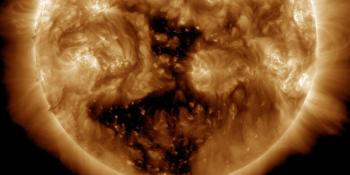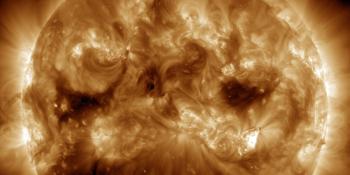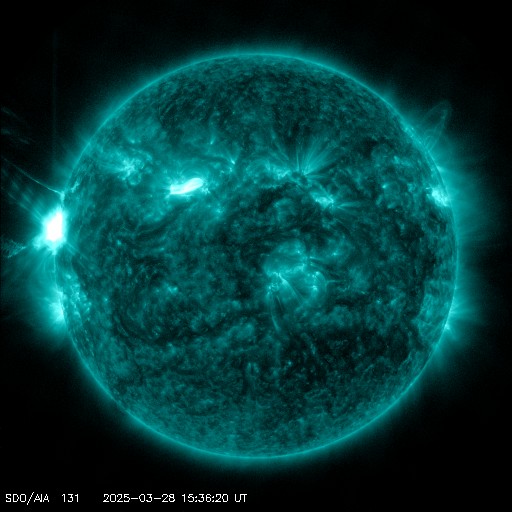Viewing archive of Thursday, 26 December 2002
Solar activity report
Any mentioned solar flare in this report has a scaling factor applied by the Space Weather Prediction Center (SWPC). Because of the SWPC scaling factor, solar flares are reported as 42% smaller than for the science quality data. The scaling factor has been removed from our archived solar flare data to reflect the true physical units.
Report of Solar-Geophysical Activity 2002 Dec 26 2200 UTCPrepared by the NOAA © SWPC and processed by SpaceWeatherLive.com
Joint USAF/NOAA Report of Solar and Geophysical Activity
SDF Number 360 Issued at 2200Z on 26 Dec 2002IA. Analysis of Solar Active Regions and Activity from 25-2100Z to 26-2100Z
Solar Activity has been low during the past 24 hours.
Today's flare activity consisted of a few low-level C-class
subflares. A backward C-shaped filament erupted off the disk at
about 1805 UTC today. The filament eruption was associated with a
fast, narrow CME off the northeast limb, first seen in the C2 field
of view at 1854 UTC. The estimated CME velocity in C2 was about 715
km/s.
IB. Solar Activity Forecast
Solar activity is expected to be low
for the next three days.
IIA. Geophysical Activity Summary 25-2100Z to 26-2100Z
The geomagnetic field ranged from quiet to active levels. Solar wind
data seem to indicate the onset of a high speed coronal hole wind
stream around 1600 UTC, with speeds up to about 500 km/s.
IIB. Geophysical Activity Forecast
The geomagnetic field is
expected to be mostly active for the next two days in response to
the high speed solar wind stream associated with a 30 degree wide
solar coronal hole. Conditions should subside slightly to unsettled
to active levels by the third day.
III. Event Probabilities 27 Dec to 29 Dec
| Class M | 15% | 15% | 15% |
| Class X | 01% | 01% | 01% |
| Proton | 01% | 01% | 01% |
| PCAF | green | ||
IV. Penticton 10.7 cm Flux
Observed 26 Dec 127 Predicted 27 Dec-29 Dec 125/120/115 90 Day Mean 26 Dec 166
V. Geomagnetic A Indices
Observed Afr/Ap 25 Dec 010/014 Estimated Afr/Ap 26 Dec 010/015 Predicted Afr/Ap 27 Dec-29 Dec 016/020-016/025-012/020
VI. Geomagnetic Activity Probabilities 27 Dec to 29 Dec
| A. Middle Latitudes | |||
|---|---|---|---|
| Active | 50% | 50% | 40% |
| Minor storm | 20% | 20% | 15% |
| Major-severe storm | 05% | 05% | 01% |
| B. High Latitudes | |||
|---|---|---|---|
| Active | 35% | 35% | 25% |
| Minor storm | 30% | 30% | 20% |
| Major-severe storm | 15% | 15% | 05% |
All times in UTC
Current data suggests there is a slight possibility for aurora to appear at the following high latitude regions in the near future
Norilsk, VorkutaLatest news
Latest forum messages
AR4046 47AR4043 36Incoming & Unnumbered Active Regions 1653Filaments and prominences 748The multiple event last week. 2
More topicsSupport SpaceWeatherLive.com!
A lot of people come to SpaceWeatherLive to follow the Sun's activity or if there is aurora to be seen, but with more traffic comes higher server costs. Consider a donation if you enjoy SpaceWeatherLive so we can keep the website online!

Latest alerts
15:45 UTC - 10cm Radio Burst
Begin Time: 28/02/2025 15:06 UTC Maximum Time: 28/02/2025 15:14 UTC Duration: 24 minutes. Peak flux: 380 sfu
15:45 UTC - Type IV Radio Emission
Begin Time: 28/03/2025 15:14 UTC
15:42 UTC - Solar flare
Major X1.14 flare from sunspot region 4046
15:21 UTC - Radio Blackout
Strong R3 radio blackout in progress (≥X1 - current: X1.08)
15:18 UTC - Radio Blackout
Moderate R2 radio blackout in progress (≥M5 - current: M6.33)
Space weather facts
| Last X-flare | 2025/03/28 | X1.1 |
| Last M-flare | 2025/03/27 | M2.0 |
| Last geomagnetic storm | 2025/03/27 | Kp5 (G1) |
| Spotless days | |
|---|---|
| Last spotless day | 2022/06/08 |
| Monthly mean Sunspot Number | |
|---|---|
| February 2025 | 154.6 +17.6 |
| March 2025 | 130 -24.6 |
| Last 30 days | 130 -22.2 |



